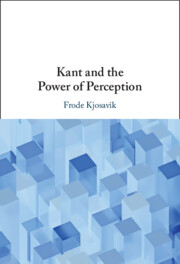Refine search
Actions for selected content:
110 results

Kant and the Power of Perception
-
- Published online:
- 27 November 2025
- Print publication:
- 11 December 2025
17 - Looking Back and Looking Ahead: What about Emotion, Culture, Artificial Intelligence, and Intuition?
- from Part III - Applications, Examples, and Selected Topics
-
- Book:
- Making Decisions: Analytics, Cognition, and Application
- Published online:
- 23 October 2025
- Print publication:
- 06 November 2025, pp 247-252
-
- Chapter
- Export citation
1 - The Big Picture of Analytics Science
-
- Book:
- Insight-Driven Problem Solving
- Published online:
- 21 October 2025
- Print publication:
- 30 October 2025, pp 12-52
-
- Chapter
- Export citation

The Indispensability of Intuitions
-
- Published online:
- 21 October 2025
- Print publication:
- 13 November 2025
-
- Element
- Export citation
Chapter 2 - How Thought Experiments Work
- from Part I - The Origins of “Thought Experiment” in Kant and Ørsted
-
- Book:
- Kierkegaard and the Structure of Imagination
- Published online:
- 26 September 2025
- Print publication:
- 16 October 2025, pp 35-46
-
- Chapter
- Export citation
Chapter 5 - Rationalism and the Question of Intellectual Intuition
- from Part I - The Origins of “Thought Experiment” in Kant and Ørsted
-
- Book:
- Kierkegaard and the Structure of Imagination
- Published online:
- 26 September 2025
- Print publication:
- 16 October 2025, pp 76-86
-
- Chapter
- Export citation
Chapter 9 - Bizarre Cases and Context
- from Part II - A Kantian Account of Thought Experiment
-
- Book:
- Kierkegaard and the Structure of Imagination
- Published online:
- 26 September 2025
- Print publication:
- 16 October 2025, pp 138-154
-
- Chapter
- Export citation
Chapter 4 - Empiricism and Kantian Accounts of Thought Experiment
- from Part I - The Origins of “Thought Experiment” in Kant and Ørsted
-
- Book:
- Kierkegaard and the Structure of Imagination
- Published online:
- 26 September 2025
- Print publication:
- 16 October 2025, pp 63-75
-
- Chapter
- Export citation
Re-Thinking Intuition as Relational in Education
-
- Journal:
- Australian Journal of Environmental Education / Volume 41 / Issue 2 / May 2025
- Published online by Cambridge University Press:
- 19 May 2025, pp. 367-382
-
- Article
-
- You have access
- Open access
- HTML
- Export citation
Experimenting with philosophy of religion: Lessons from two decades of experimental philosophy
-
- Journal:
- Religious Studies / Volume 61 / Issue S1 / July 2025
- Published online by Cambridge University Press:
- 10 April 2025, pp. S5-S21
- Print publication:
- July 2025
-
- Article
-
- You have access
- Open access
- HTML
- Export citation
Altruism, fast and slow? Evidence from a meta-analysis and a new experiment
-
- Journal:
- Experimental Economics / Volume 23 / Issue 4 / December 2020
- Published online by Cambridge University Press:
- 14 March 2025, pp. 979-1001
-
- Article
-
- You have access
- Open access
- HTML
- Export citation
Cognitive Reflection and Religious Belief: A Test of Two Models
-
- Journal:
- Judgment and Decision Making / Volume 20 / 2025
- Published online by Cambridge University Press:
- 31 January 2025, e13
-
- Article
-
- You have access
- Open access
- HTML
- Export citation
The intuitive cooperation hypothesis revisited: a meta-analytic examination of effect size and between-study heterogeneity
-
- Journal:
- Journal of the Economic Science Association / Volume 6 / Issue 1 / June 2020
- Published online by Cambridge University Press:
- 17 January 2025, pp. 26-42
-
- Article
-
- You have access
- Open access
- HTML
- Export citation
6 - Discovering a Candidate Phenomenon
- from Part II - Points of Departure
-
-
- Book:
- The Cambridge Handbook of Methods in Conversation Analysis
- Published online:
- 06 December 2024
- Print publication:
- 05 December 2024, pp 143-171
-
- Chapter
- Export citation
Robert Clewis and the Origins of Kant’s Conception of Aesthetics
-
- Journal:
- Kantian Review / Volume 29 / Issue 4 / December 2024
- Published online by Cambridge University Press:
- 15 January 2025, pp. 645-650
- Print publication:
- December 2024
-
- Article
- Export citation
10 - Adjustment of Forecasts
-
- Book:
- Ethics in Econometrics
- Published online:
- 14 November 2024
- Print publication:
- 28 November 2024, pp 232-247
-
- Chapter
- Export citation
3 - An Apperceptive Approach to the Transcendental Aesthetic
-
- Book:
- Intuition in Kant
- Published online:
- 07 March 2024
- Print publication:
- 14 March 2024, pp 73-109
-
- Chapter
- Export citation
5 - Infinity, Discursivity, Givenness
-
- Book:
- Intuition in Kant
- Published online:
- 07 March 2024
- Print publication:
- 14 March 2024, pp 132-172
-
- Chapter
- Export citation
2 - Synthetic Judgment and Intuition
-
- Book:
- Intuition in Kant
- Published online:
- 07 March 2024
- Print publication:
- 14 March 2024, pp 44-72
-
- Chapter
- Export citation
7 - A Stufenleiter of Kantian Intuition, Part I
-
- Book:
- Intuition in Kant
- Published online:
- 07 March 2024
- Print publication:
- 14 March 2024, pp 194-216
-
- Chapter
- Export citation
